I grew up in a small-ish city, in a Ukrainian-Canadian family. A lot of my friends were, like me, second-generation Canadians who had grandparents cooking, not only Ukrainian food, but also Italian, Polish and Finnish. There were a lot of European flavours around when I was a kid, but Indian food…that took me a bit longer to discover.
The first time I found out about Indian food was when I graduated University at twenty-two years old and went to temporarily live in London, England with my girlfriends. People there weren’t eating late-night pizza after the bar in London. Instead, they went for take-away curry. That turned out to be a staple of my London diet, but once I left I don’t think I had another curry for about seven years, until I found myself in India.
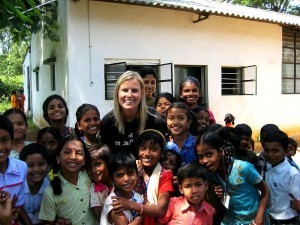 Because Indian food was something I had only had in the wee hours of the morning, my recollection of what to order was a bit foggy. I spent a summer in India and developed a wild love affair with naan bread, because it was the only thing I could order where I’d actually know what was arriving at the table. I was lost looking at the menus, had no idea what to order, and half the time couldn’t eat what came out of the kitchen because the dishes I ordered were just too spicy to eat. The result? I lost almost twenty pounds during my time in India.
Because Indian food was something I had only had in the wee hours of the morning, my recollection of what to order was a bit foggy. I spent a summer in India and developed a wild love affair with naan bread, because it was the only thing I could order where I’d actually know what was arriving at the table. I was lost looking at the menus, had no idea what to order, and half the time couldn’t eat what came out of the kitchen because the dishes I ordered were just too spicy to eat. The result? I lost almost twenty pounds during my time in India.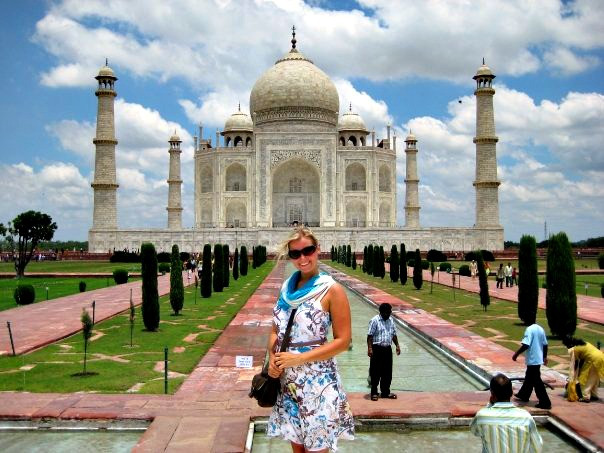
I had nearly given up on Indian food.
But wait, there was hope!
Ten years after that memorable summer in India, I walked into a party in Pointe Noire, Congo and met a bubbly woman from Northern India named Pallavi.
“I made this, you have to try it,” she walked me over to the table full of international food and handed me a plate.
“It might be spicy,” she warned.
I’d been down that spicy road with Indian food before. I just put a little on my plate, to be polite, because I was sure my mouth was about to be set ablaze.
I took a bite and my taste buds woke up my eyes, which grew wide in delight!
“This is delicious!” I told her, before I was even done chewing.
Pallavi’s Indian food was bursting with flavour and just the right amount of heat. I think I went back for thirds of Pallavi’s dish that night and swore that one day, I would find out what it was she made.
Everyone loves Pallavi’s food so much that last year she held a “How-To” class for Indian cooking. I was so disappointed that I was out of town when she did it and wouldn’t be able to attend. So when I started the ‘My Expat Kitchen’ Pallavi was one of the first people I brought the idea to, not only because I really wanted to taste her food again, but because I wanted to find out how she did this culinary magic!
Indian Cooking in Africa with Pallavi
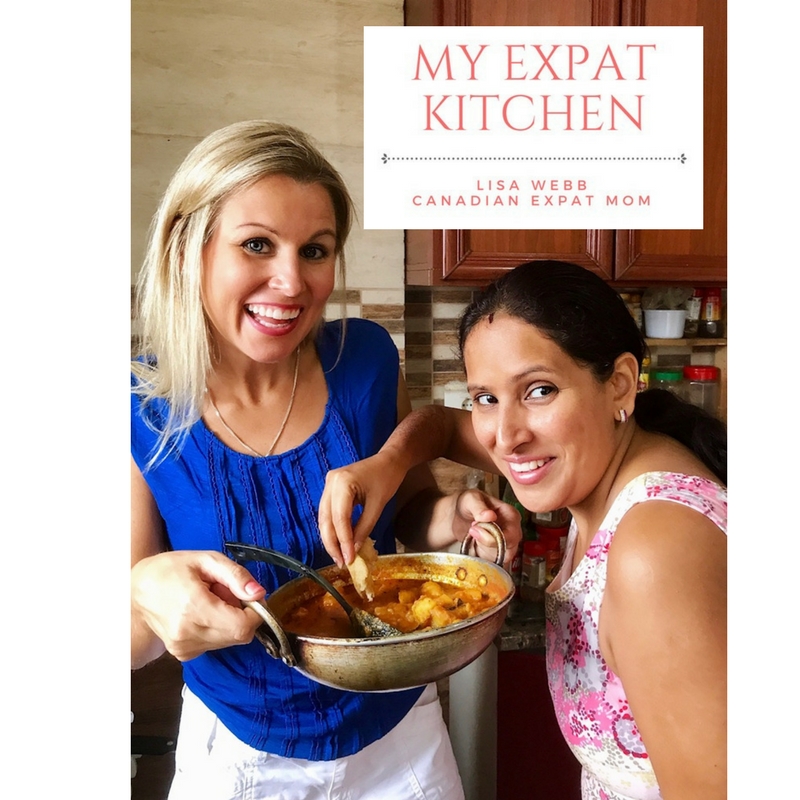 Today we’re making a traditional North Indian breakfast, and we’re making several dishes at once, so try and stay with me, and I’ll have the full recipes and instructions at the end of the post.
Today we’re making a traditional North Indian breakfast, and we’re making several dishes at once, so try and stay with me, and I’ll have the full recipes and instructions at the end of the post.
And…as a bonus, at the bottom of this post I’ve got some video highlights of our morning in the kitchen. Watch with caution if you’re hungry!

Pallavi comes from Jammu and Kashmir in the Northern most part of India and tells me that this Punjab breakfast is to die for.
When we got to Pallavi’s she had already done some prep work: boiling potatoes, soaking chick peas, grating ginger and garlic and making dough.
Let’s start by talking about those chick peas that were soaking. They were going to be used for pindi chana, which is chickpeas cooked village style. They smelled delicious and I knew that Pallavi had already done something to get them because they were smelling so good!
I was right. 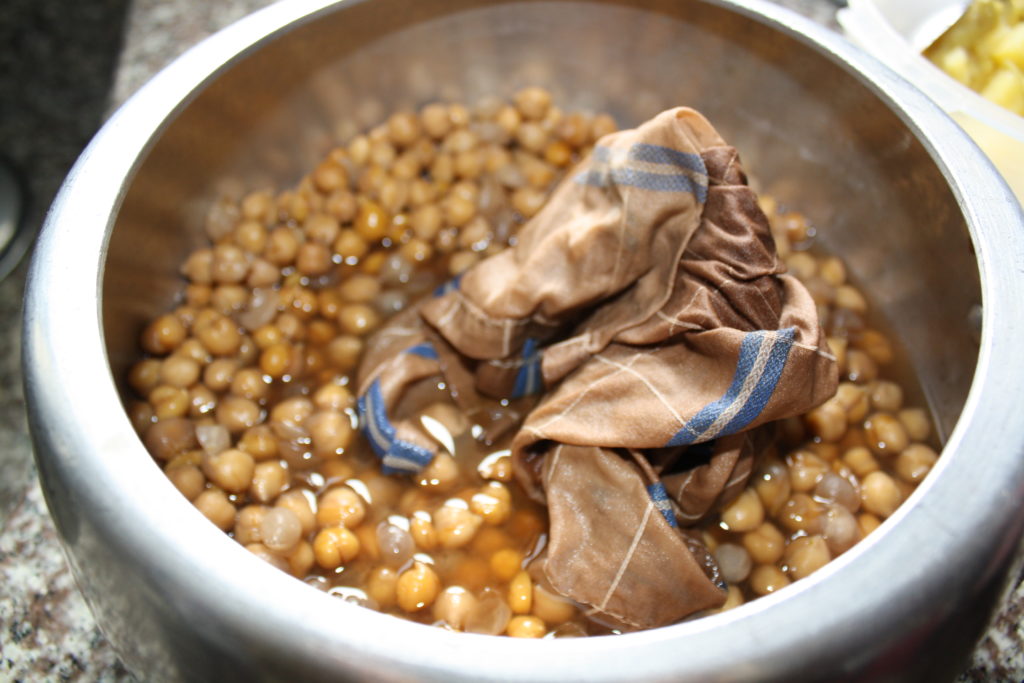 The chickpeas had been soaking overnight with a little sachet of spices (bay leaves, black and green cardamom, cinnamon stick, pepper corn, cloves and tea bags). Then they had been pressure cooked and now, they were sitting in front of me smelling simply delicious!
The chickpeas had been soaking overnight with a little sachet of spices (bay leaves, black and green cardamom, cinnamon stick, pepper corn, cloves and tea bags). Then they had been pressure cooked and now, they were sitting in front of me smelling simply delicious!
Pallavi opened the spice package so I could see what was hiding in there.
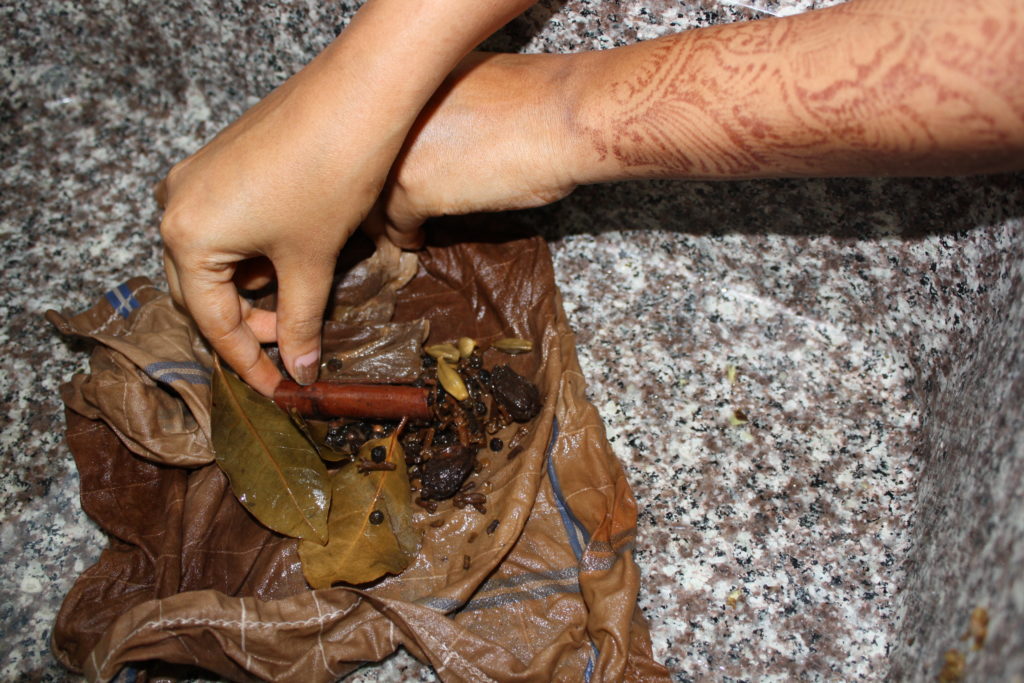 We drained the chickpeas, but saved the liquid.
We drained the chickpeas, but saved the liquid.
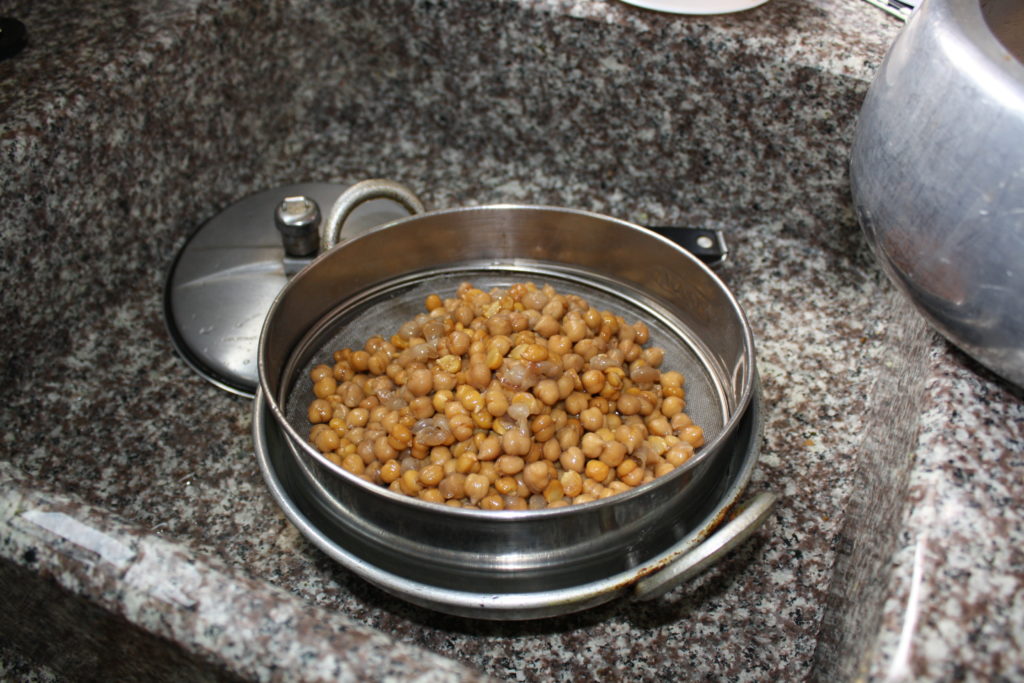 Then the magic started happening. Pallavi began adding all kinds of spices without a measuring tool in sight. And take it from me, this girl has her spice cupboard stocked!
Then the magic started happening. Pallavi began adding all kinds of spices without a measuring tool in sight. And take it from me, this girl has her spice cupboard stocked!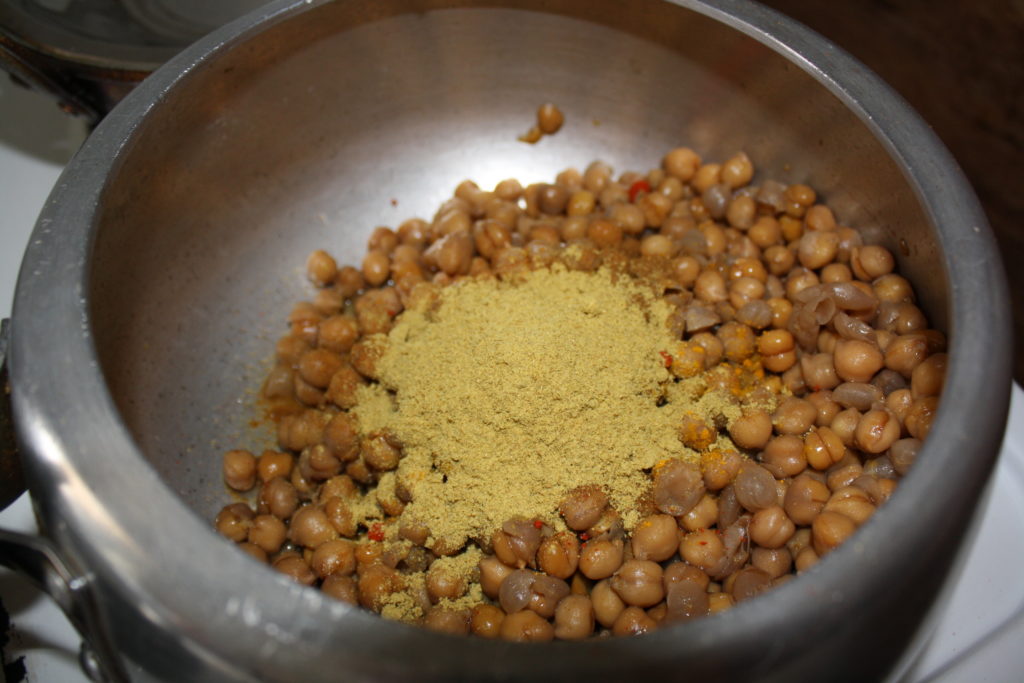 One spice after another was added to the pot, each time stopping to tell me what she added and let me have a smell.
One spice after another was added to the pot, each time stopping to tell me what she added and let me have a smell.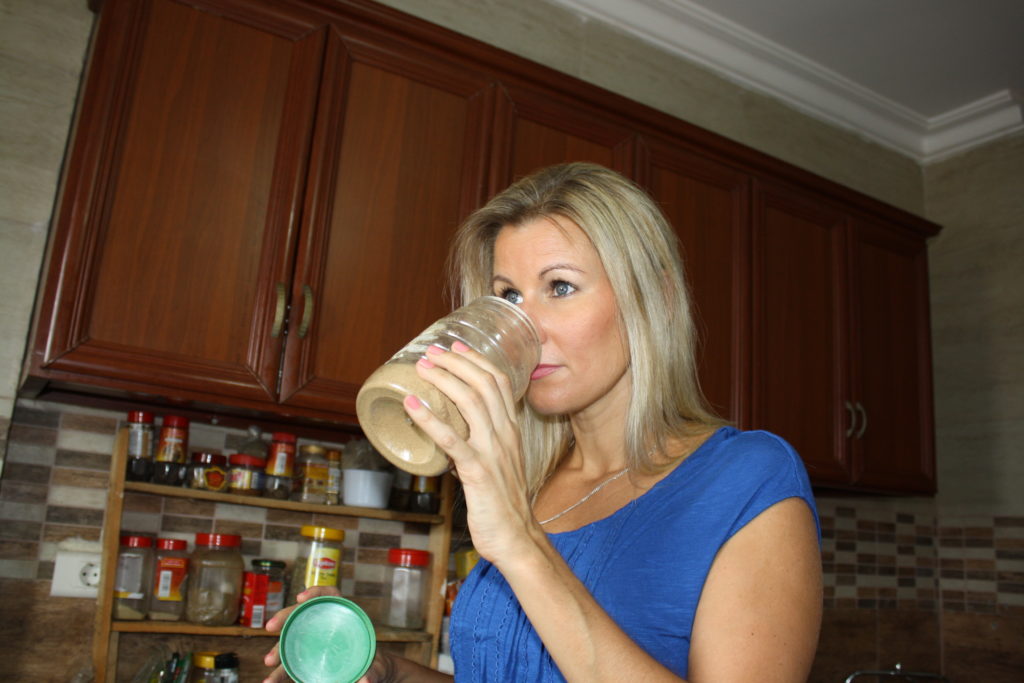 By the time the spice train stopped, we had added turmeric, chilli powder, cumin powder, coriander powder, chhole Masala, dried mango powder, and pomegranate seeds.
By the time the spice train stopped, we had added turmeric, chilli powder, cumin powder, coriander powder, chhole Masala, dried mango powder, and pomegranate seeds.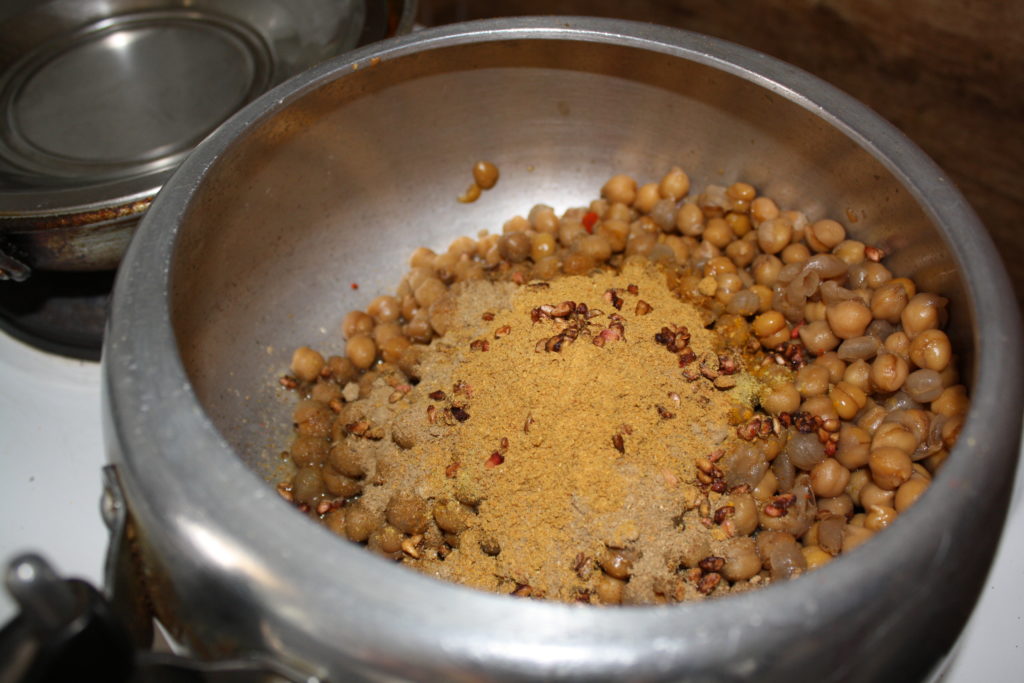 In a neighbouring pan we warmed up some ghee (clarified butter), which Pallavi informed me that she uses in almost all her cooking.
In a neighbouring pan we warmed up some ghee (clarified butter), which Pallavi informed me that she uses in almost all her cooking.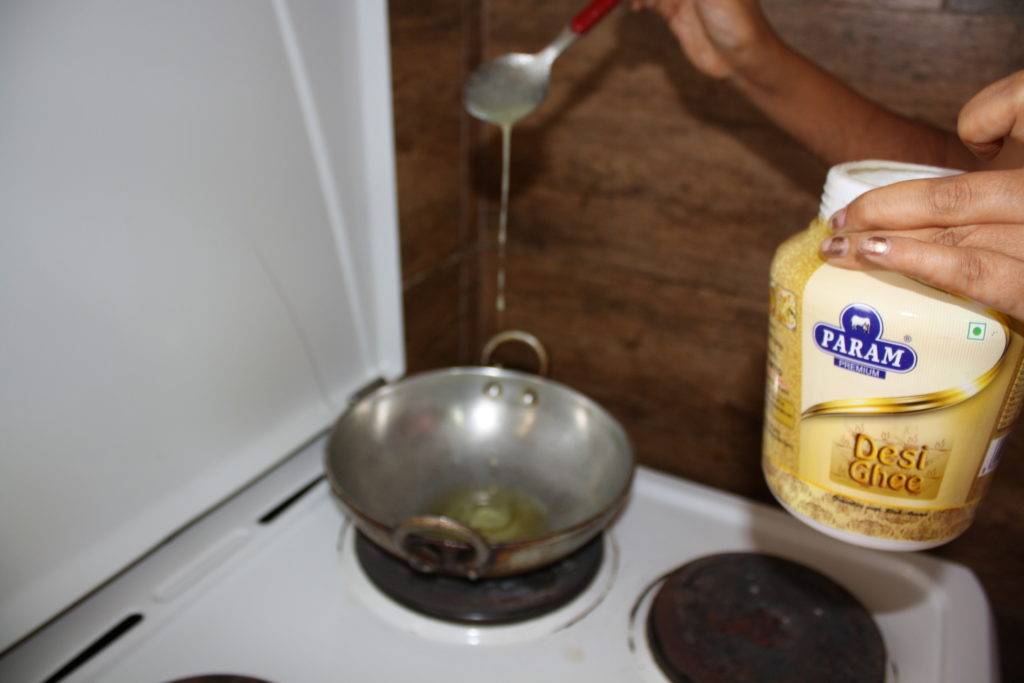 Once the ghee was hot we added cumin, carrom seeds and asofoetida.
Once the ghee was hot we added cumin, carrom seeds and asofoetida.  Next came the ginger and garlic and it cooked for about thirty seconds.
Next came the ginger and garlic and it cooked for about thirty seconds.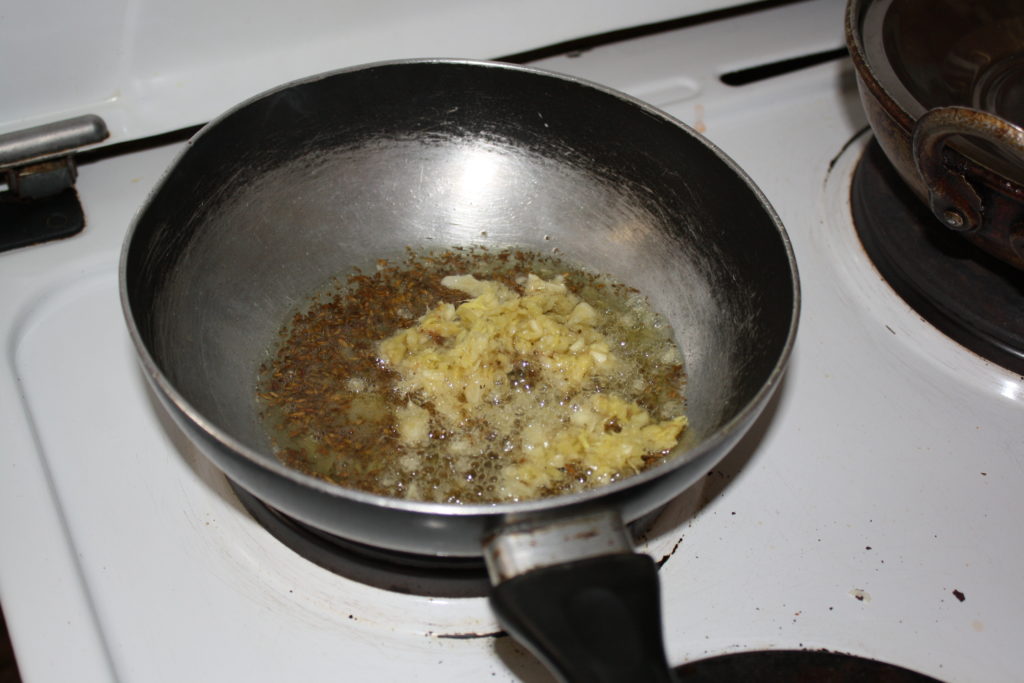 We poured all this over the chickpeas and added the chickpea water and tamarind pulp.
We poured all this over the chickpeas and added the chickpea water and tamarind pulp. 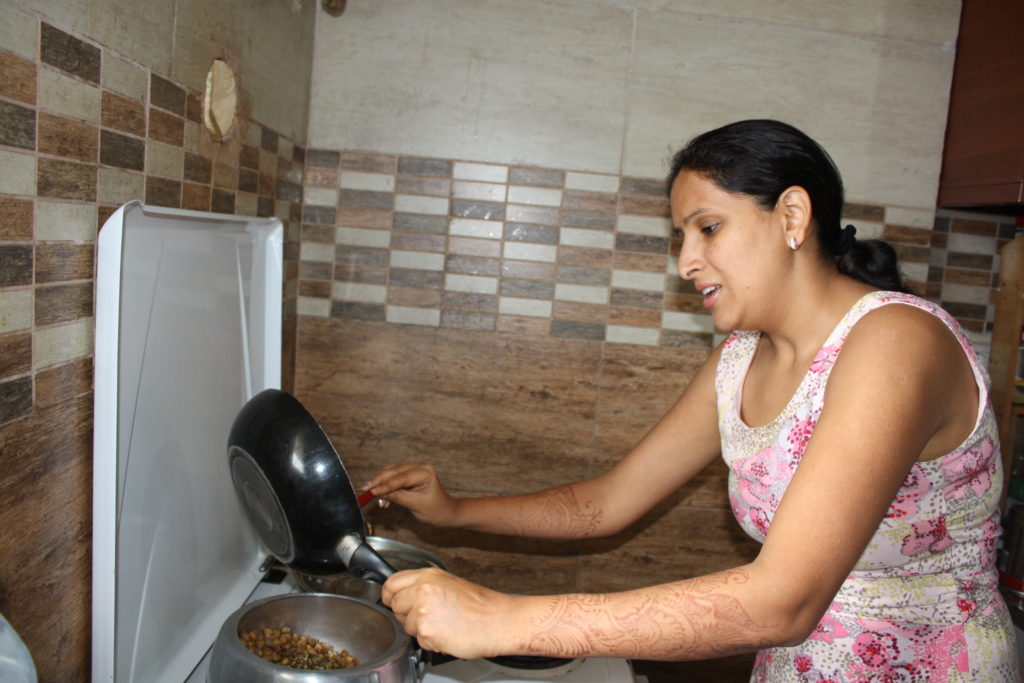
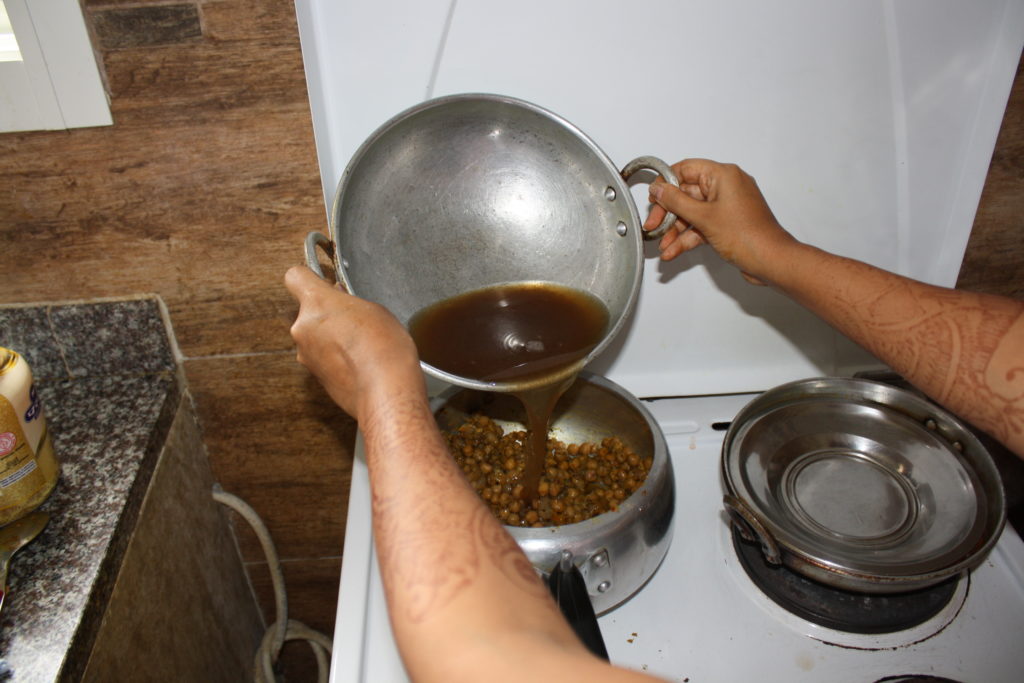 Then cover and let it cook for 5-10 minutes. Add garam Masala and chopped coriander. That dish was all set and would later be served topped with red onions when served.
Then cover and let it cook for 5-10 minutes. Add garam Masala and chopped coriander. That dish was all set and would later be served topped with red onions when served.
Onto the next master piece!
Simultaneously with the chickpea dish, we were also making hing wale a loo (potatoes with asofoetida).
Pallavi had already boiled the potatoes and told me the secret was to mash them with your hands, so after a thorough washing, I got right in there!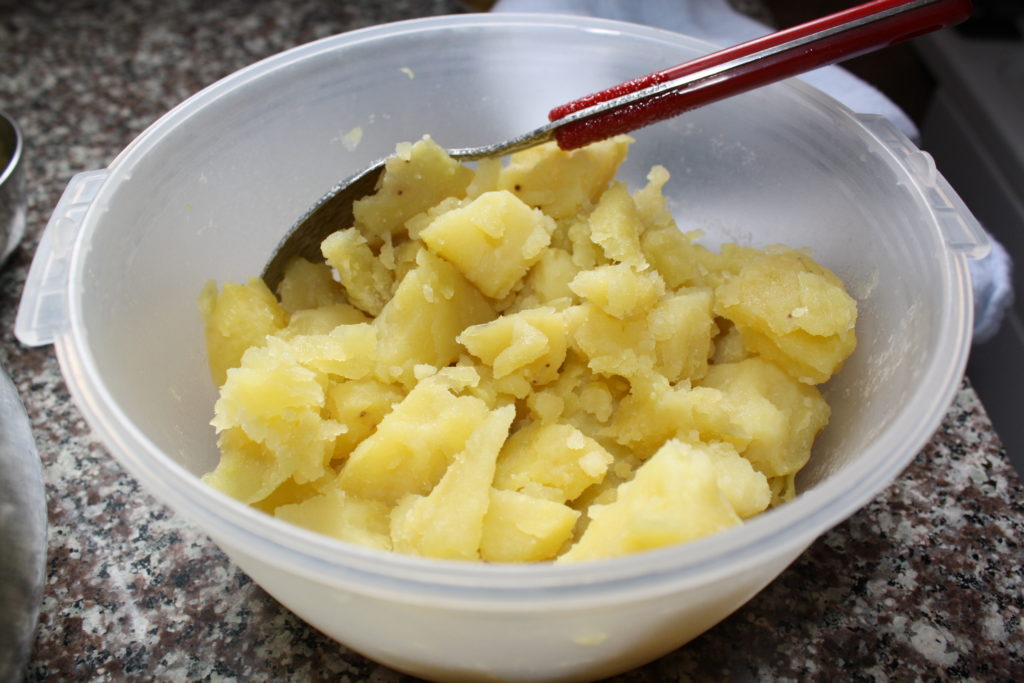 We heat more ghee in another wok.
We heat more ghee in another wok.  In advance, Pallavi had pureed three big tomatoes with green chillies and ginger. Once the ghee was hot, we added the pureed mixture and let it cook for three minutes.
In advance, Pallavi had pureed three big tomatoes with green chillies and ginger. Once the ghee was hot, we added the pureed mixture and let it cook for three minutes. 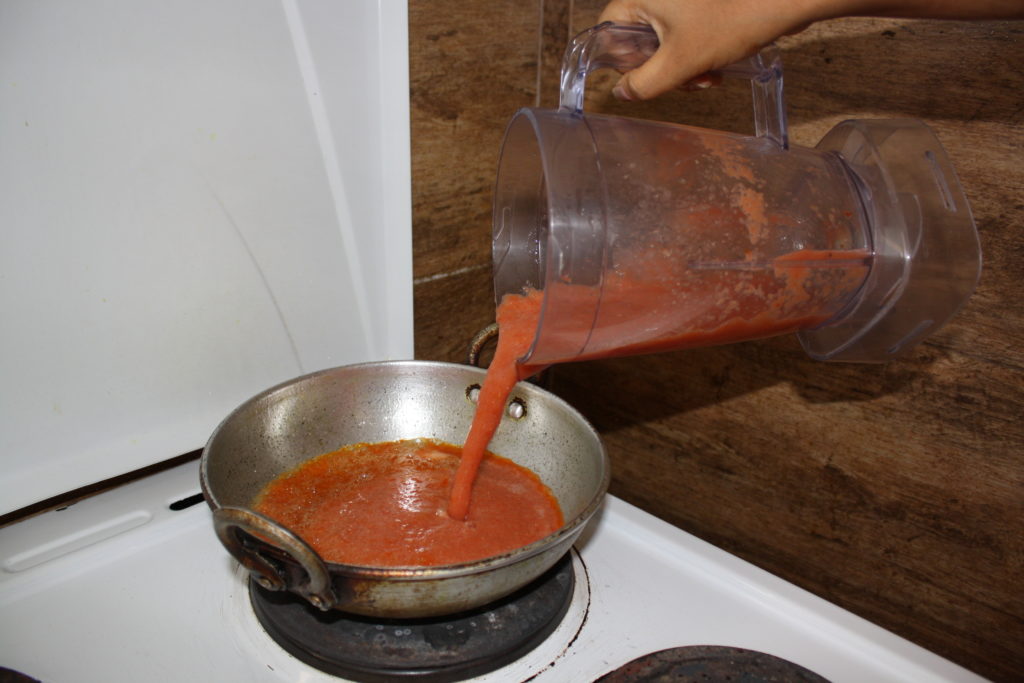 We took two finely chopped tomatoes and added them to the wok, covering it and letting it cook for ten minutes, until the chopped tomatoes were cooked.
We took two finely chopped tomatoes and added them to the wok, covering it and letting it cook for ten minutes, until the chopped tomatoes were cooked. 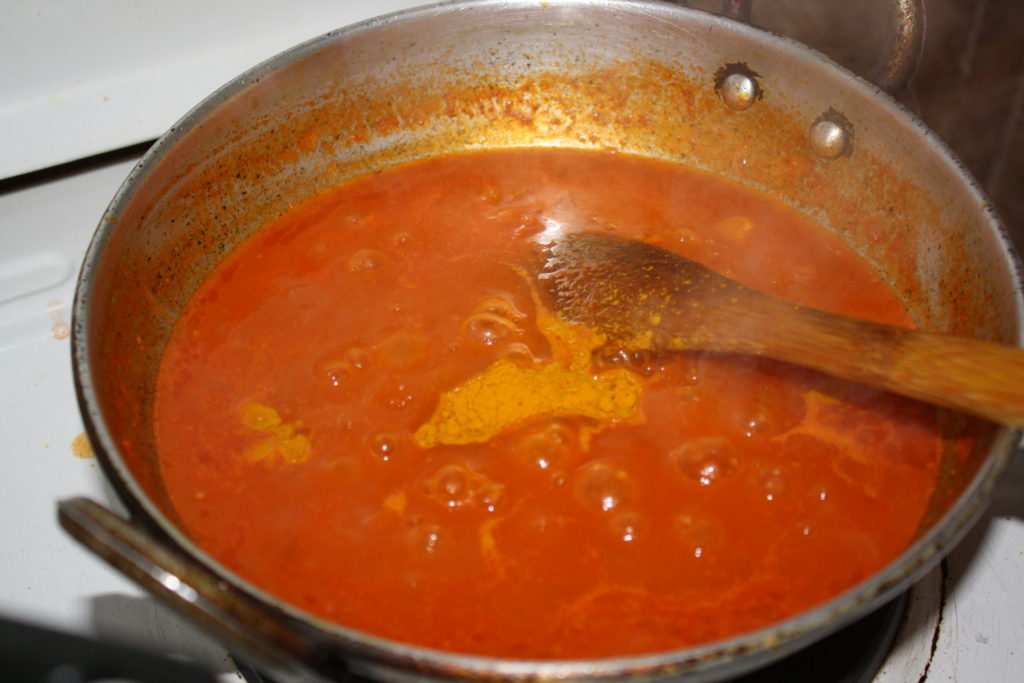 Once again Pallavi did her spice magic with the only thing guiding her being the lid of the spices. She put in turmeric, asofoetida, fennel powder, salt and chilli powder.
Once again Pallavi did her spice magic with the only thing guiding her being the lid of the spices. She put in turmeric, asofoetida, fennel powder, salt and chilli powder. 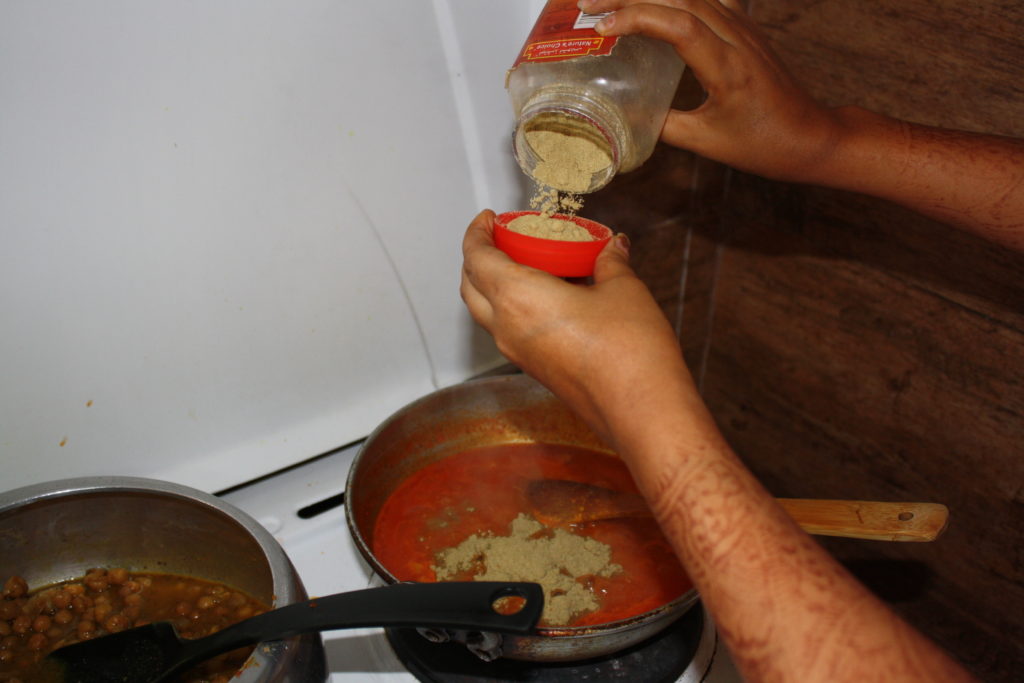 We mixed it up and let it cook for five minutes.
We mixed it up and let it cook for five minutes. 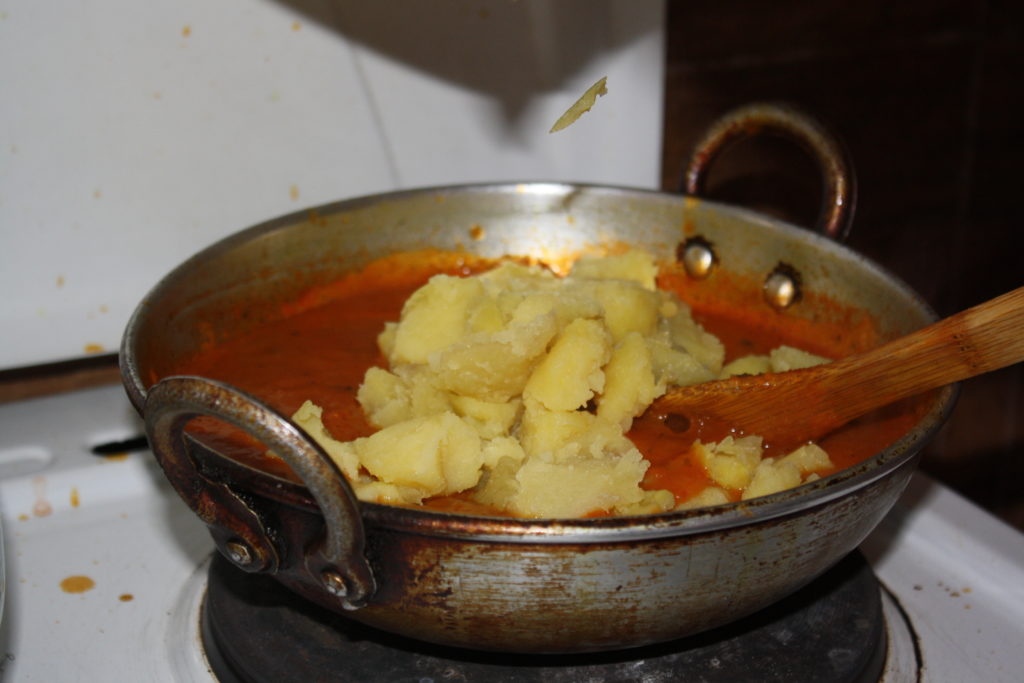 We put in the potatoes, mixed it up and added in some water(according to your desired consistency). This is when you can add chopped coriander(cilantro) if you like. Pallavi continued to add dried fenugreek leaves and garam Masala.
We put in the potatoes, mixed it up and added in some water(according to your desired consistency). This is when you can add chopped coriander(cilantro) if you like. Pallavi continued to add dried fenugreek leaves and garam Masala. 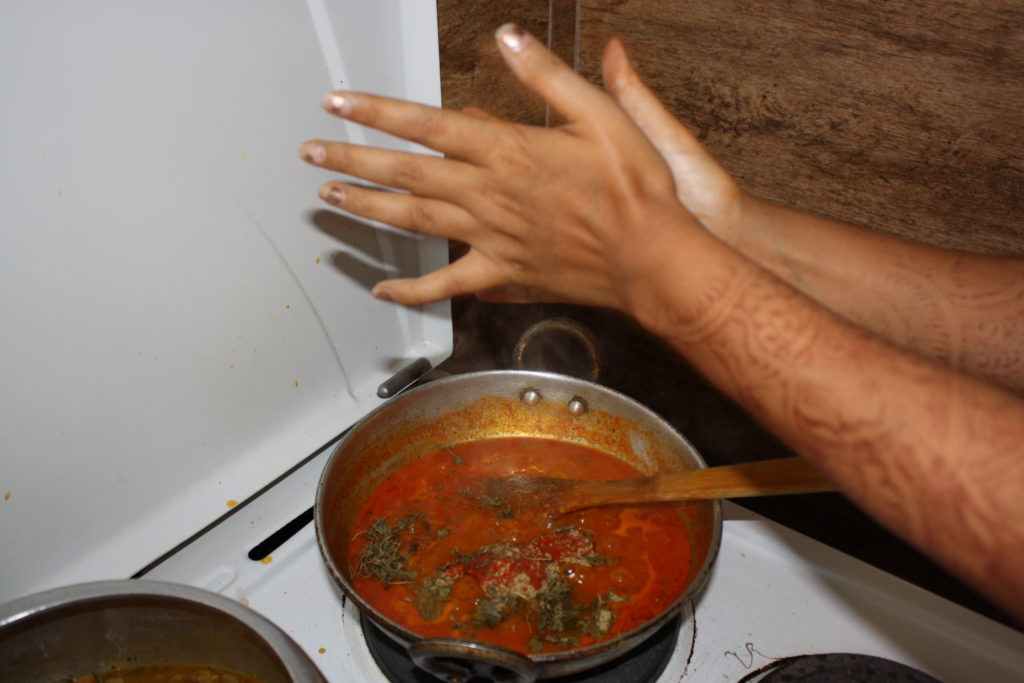 We gave it final mix and cooked it for another couple minutes uncovered.
We gave it final mix and cooked it for another couple minutes uncovered.
And there was another dish, ready to go!
You’d think Pallavi might have stopped there, but apparently this girl doesn’t do her Indian cooking halfheartedly! Pallavi had also pre-mixed three different types of dough, and they were rising as we were making the other things.
It was time for Aloo parantha (fried flatbread with potatoes stuffing).
The dough was ready and waiting.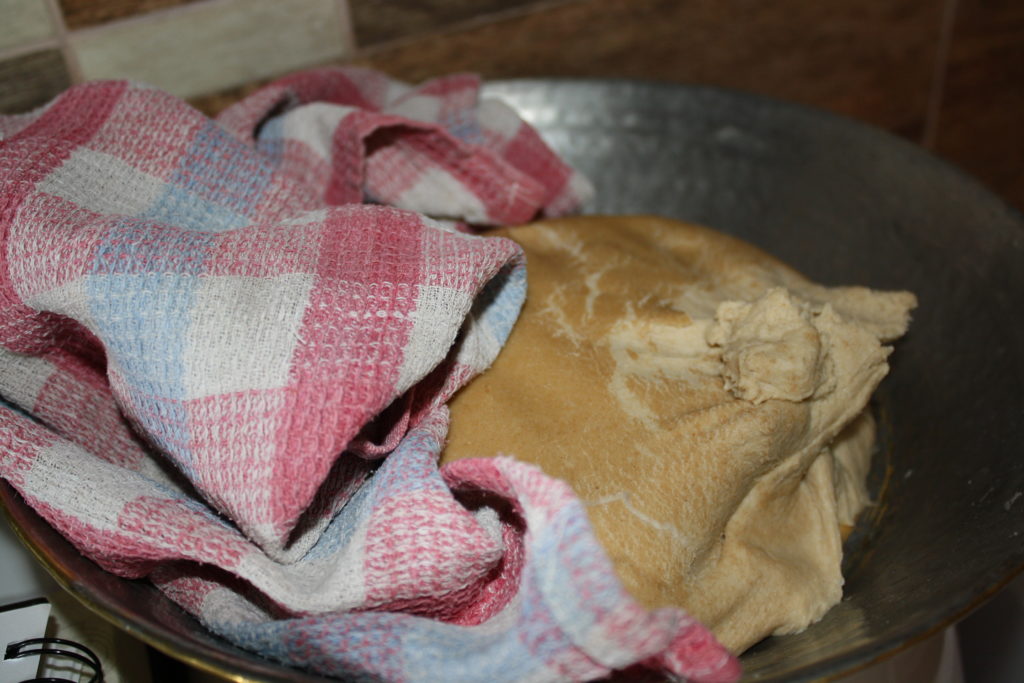 Pallavi rolled the dough into balls, handling each one with a little love.
Pallavi rolled the dough into balls, handling each one with a little love.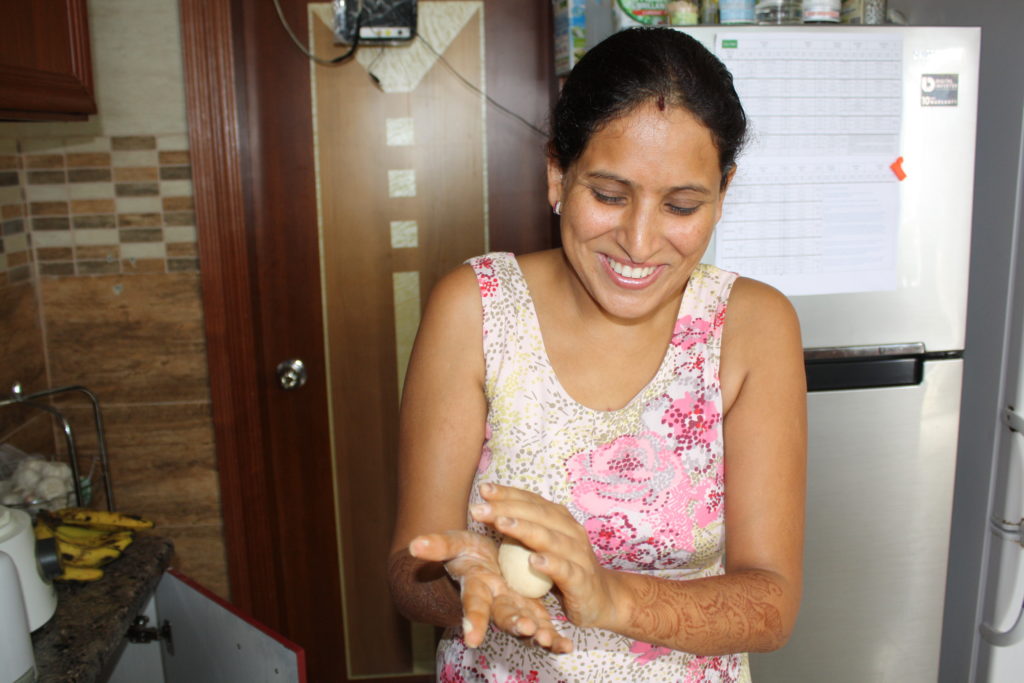
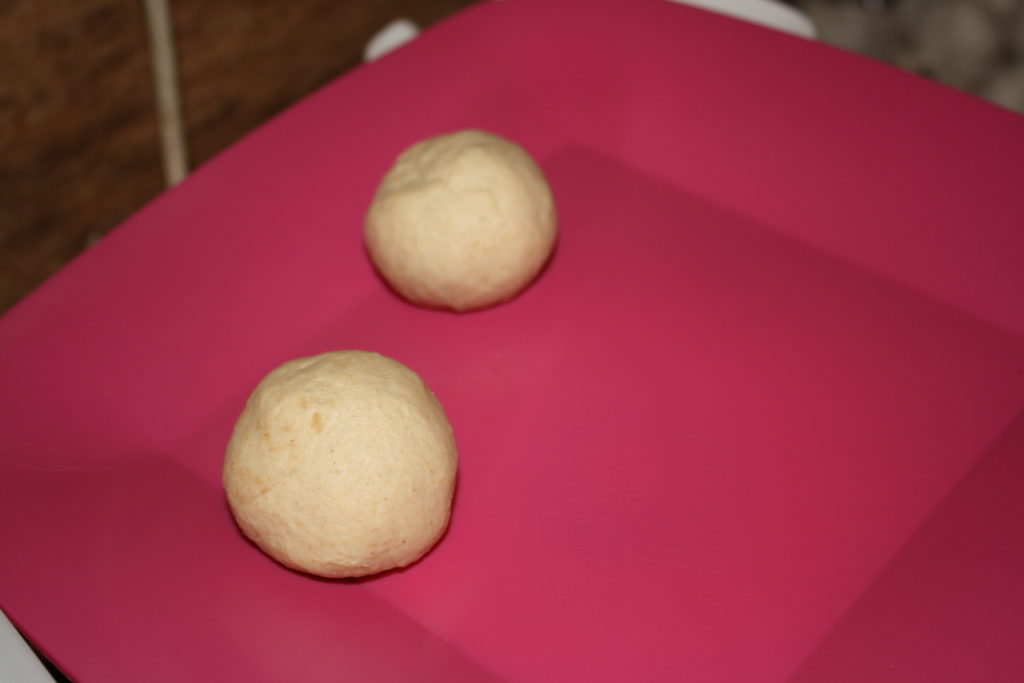 Then she rolled one out, flouring the surface at bit.
Then she rolled one out, flouring the surface at bit.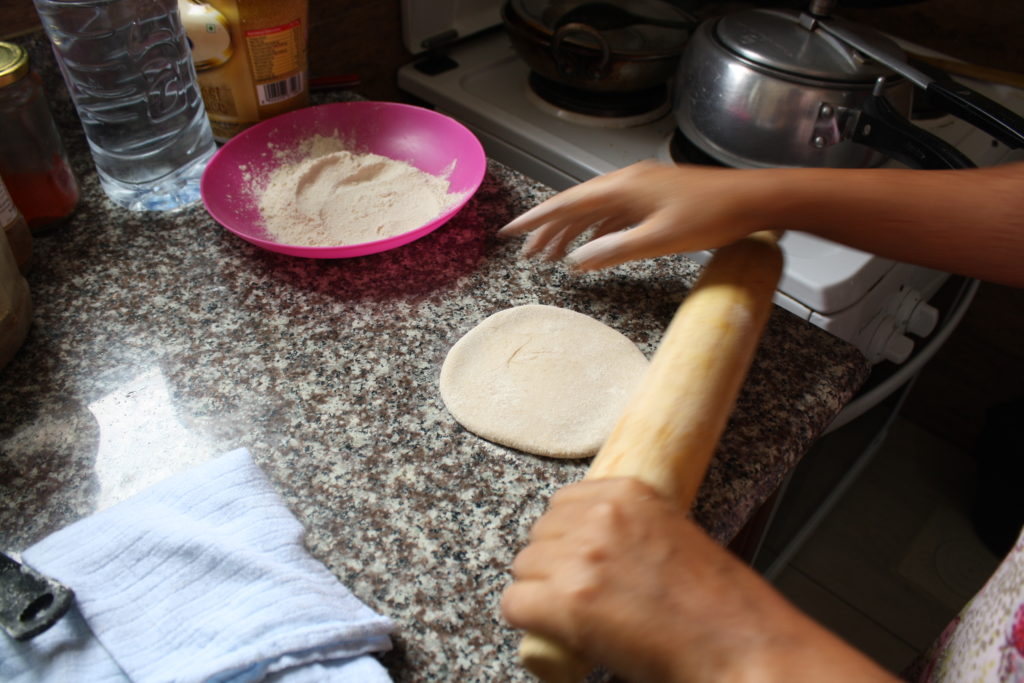 Meanwhile, while my friend was rolling dough, I was mixing mashed potatoes with chopped onions, coriander, carrom seeds, garam masala, chili powder and dry mango powder(which I only that morning found out existed).
Meanwhile, while my friend was rolling dough, I was mixing mashed potatoes with chopped onions, coriander, carrom seeds, garam masala, chili powder and dry mango powder(which I only that morning found out existed).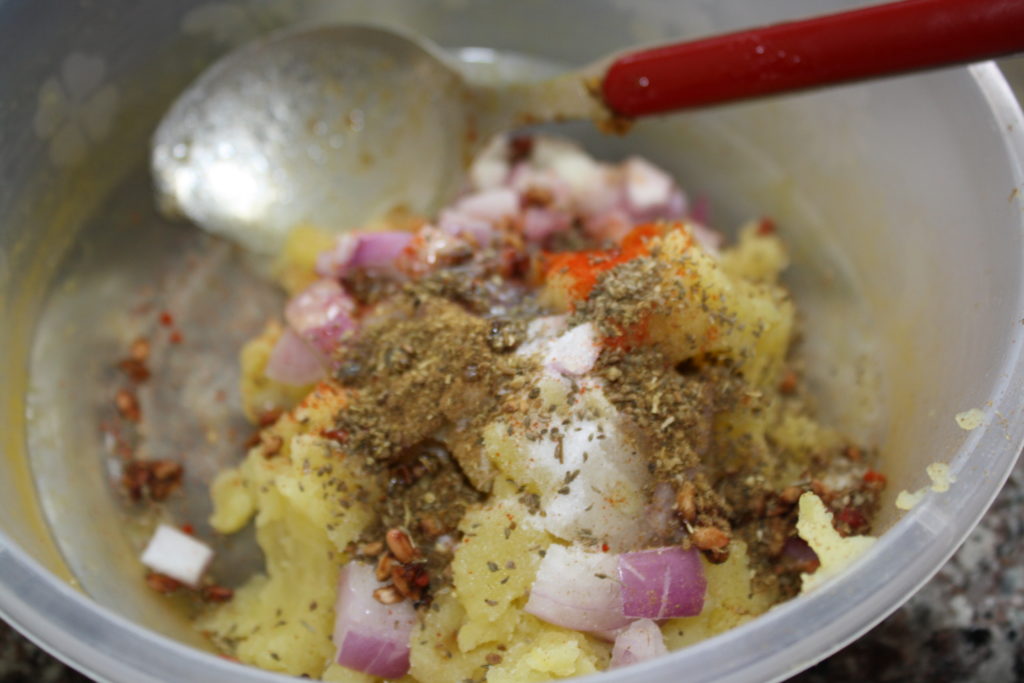 When the mixture was complete, we added a scoop of it onto the disk of rolled out dough.
When the mixture was complete, we added a scoop of it onto the disk of rolled out dough.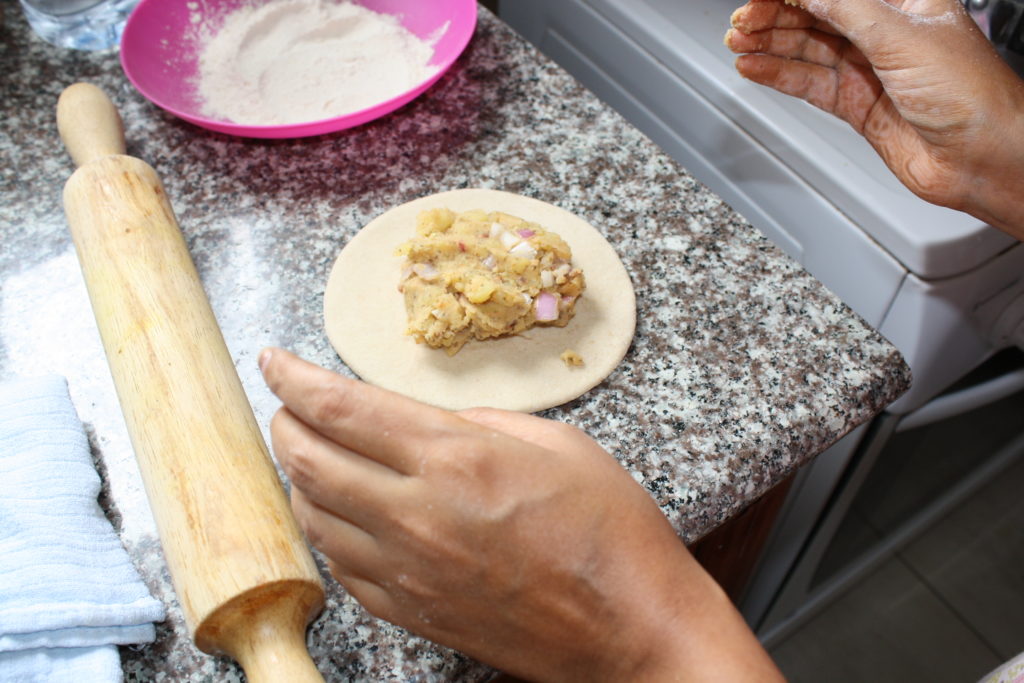 As Pallavi started putting this together, I was sure we were about to eat some sort of dumplings.
As Pallavi started putting this together, I was sure we were about to eat some sort of dumplings.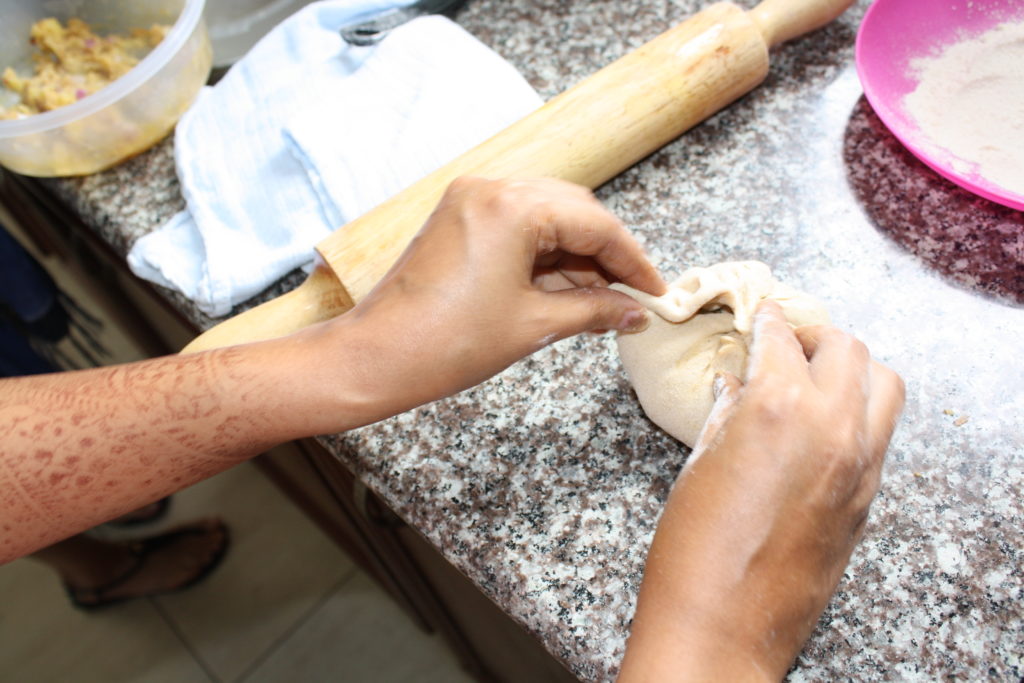 But she surprised me when just as the dumpling was finished, she started rolling it out.
But she surprised me when just as the dumpling was finished, she started rolling it out.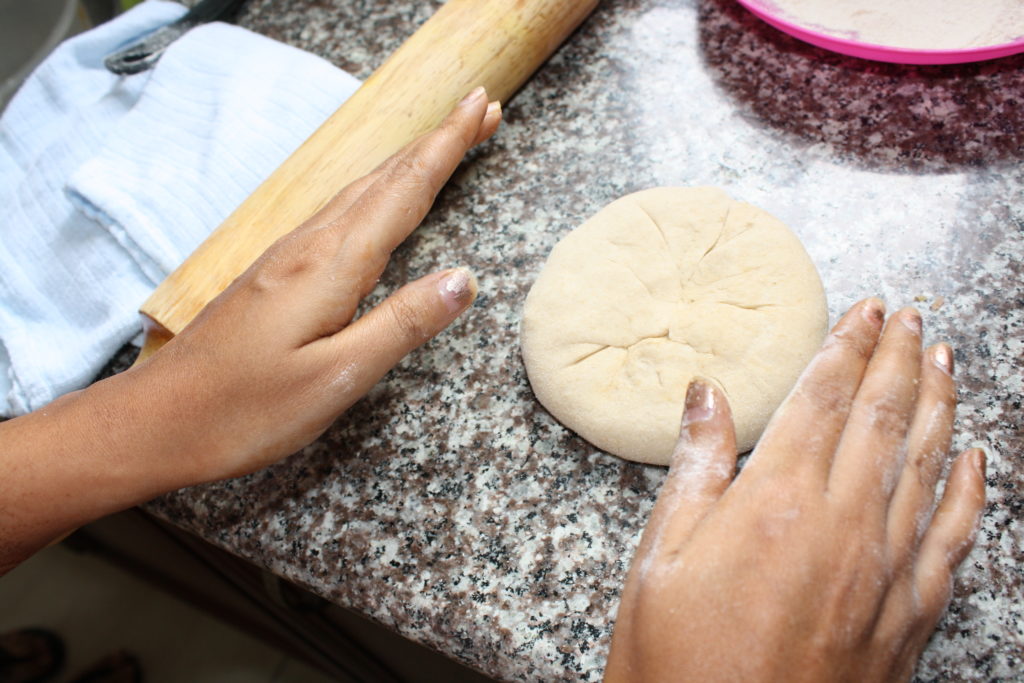 Until it was flat as a pancake.
Until it was flat as a pancake.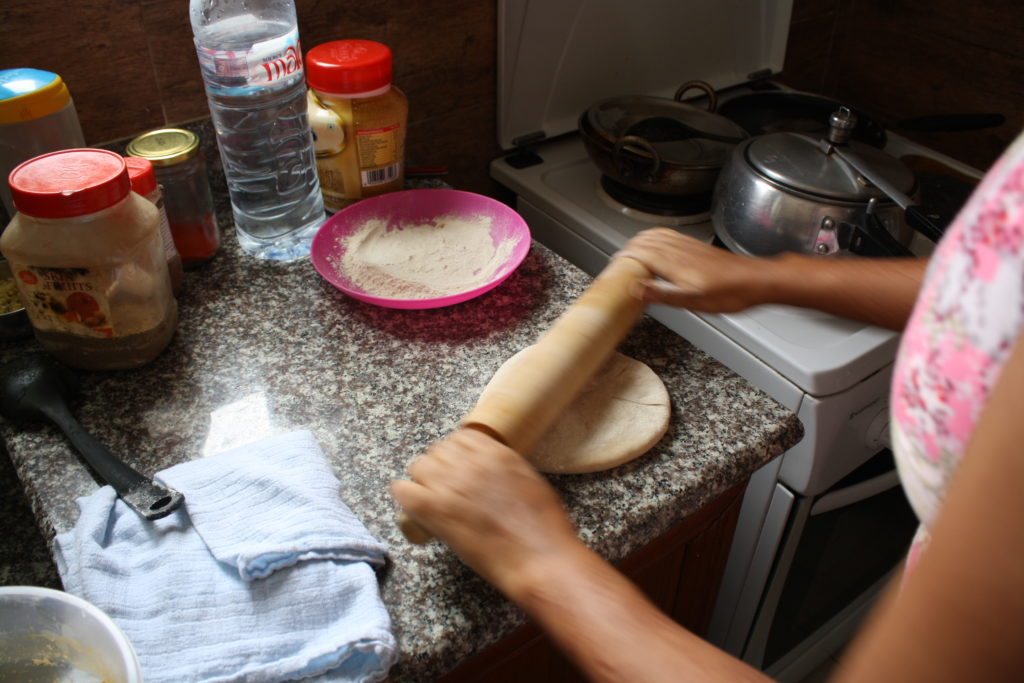 This was not what I expected!
This was not what I expected!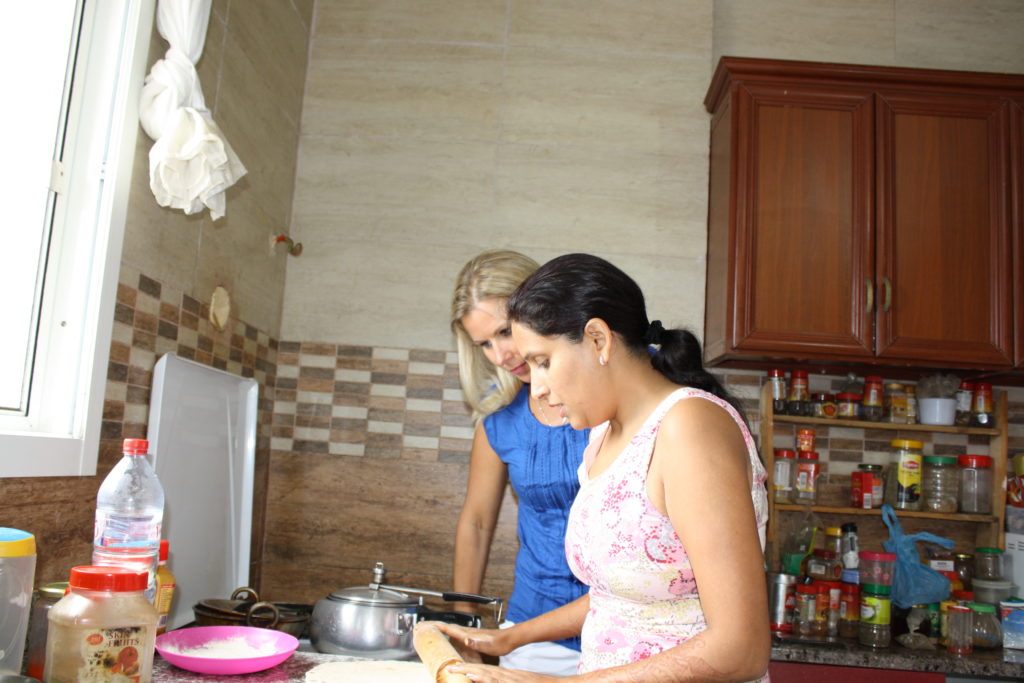 A bit more ghee in the wok and this rolled out flat bread was headed to the pan, with the onion and potato mixture now completely incorporated into the dough.
A bit more ghee in the wok and this rolled out flat bread was headed to the pan, with the onion and potato mixture now completely incorporated into the dough.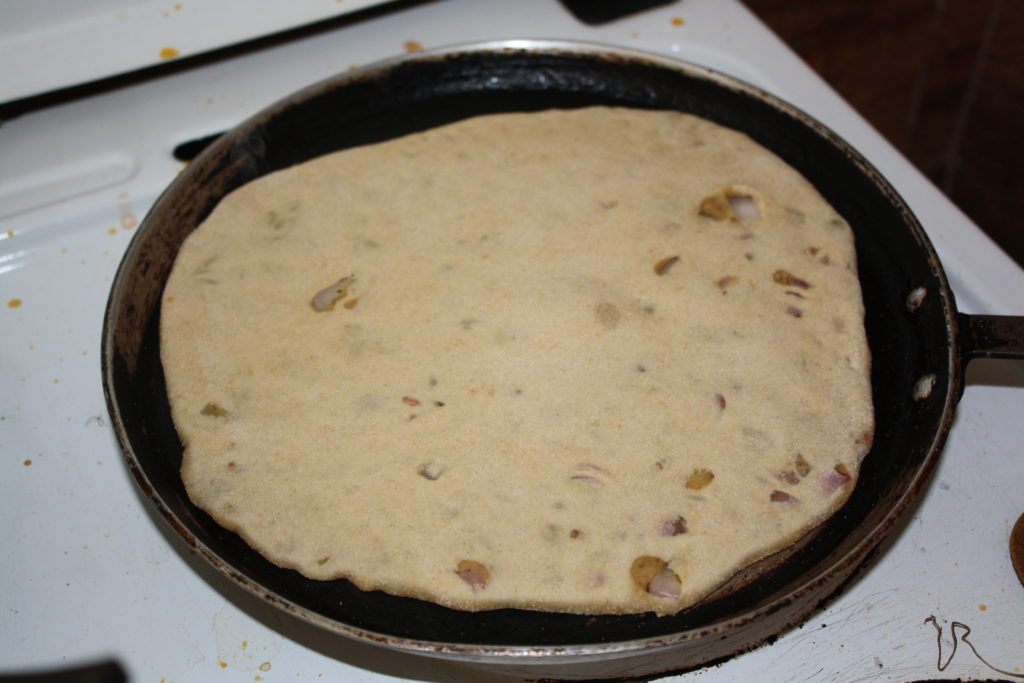 The wonderful thing about that ghee is it helped to make the bread golden and delicious!
The wonderful thing about that ghee is it helped to make the bread golden and delicious!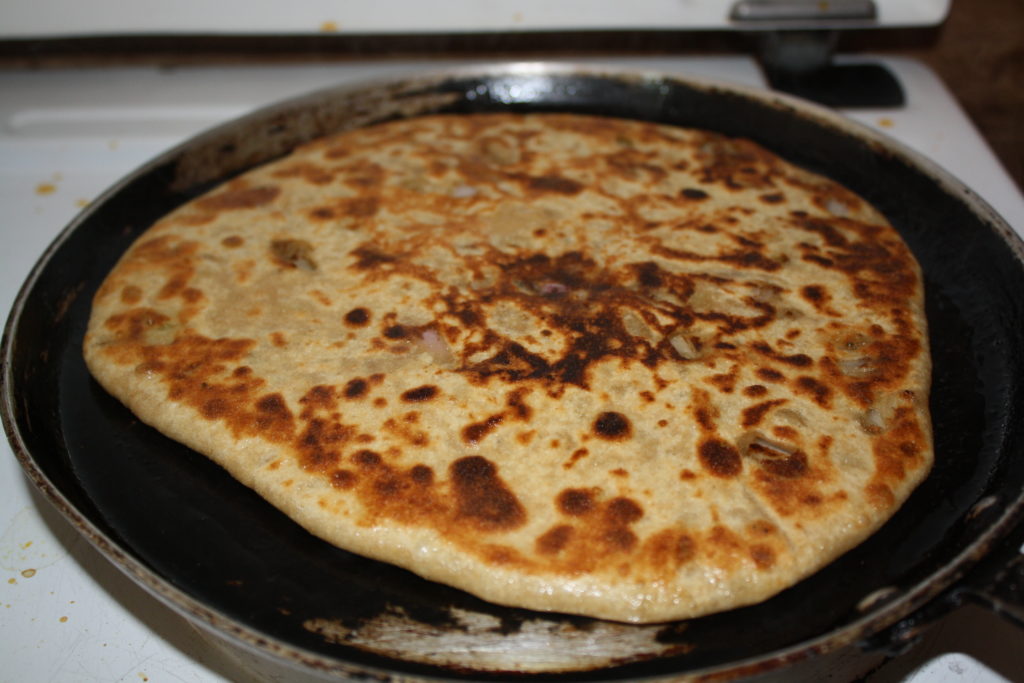 But wait…that’s not all!
But wait…that’s not all!
It was time to cook the other two breads because our hostess wanted to make sure we tried ALL the bread. She heated up a healthy dose of oil in a pan until it got really hot.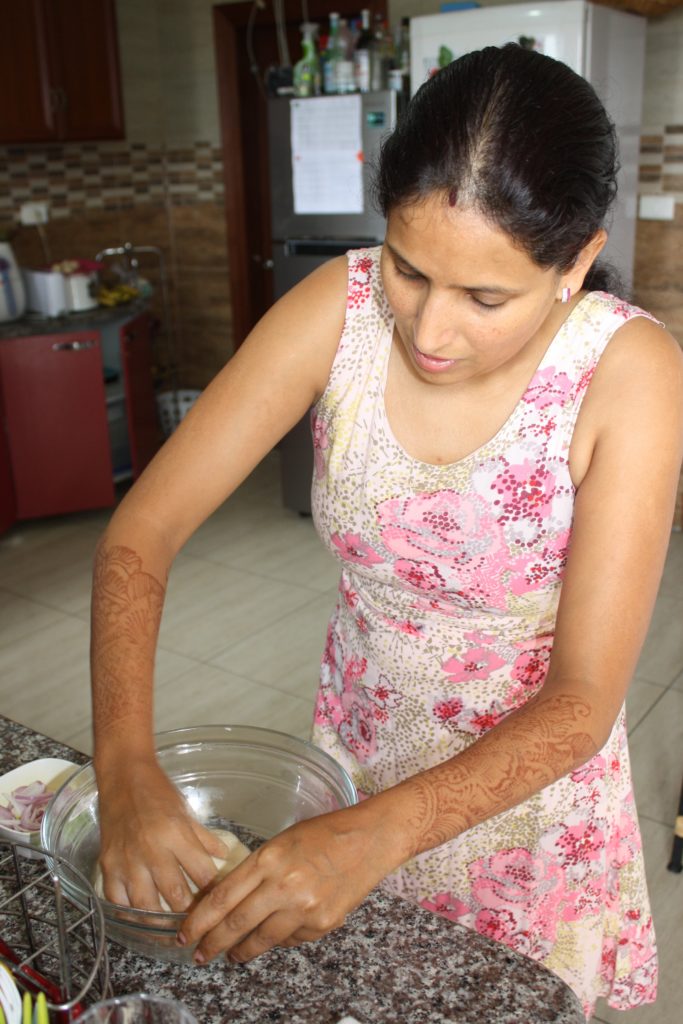 While the oil was heating, Pallavi got to rolling while I watched in amazement as she moved around her kitchen like a culinary ninja. I was in awe.
While the oil was heating, Pallavi got to rolling while I watched in amazement as she moved around her kitchen like a culinary ninja. I was in awe.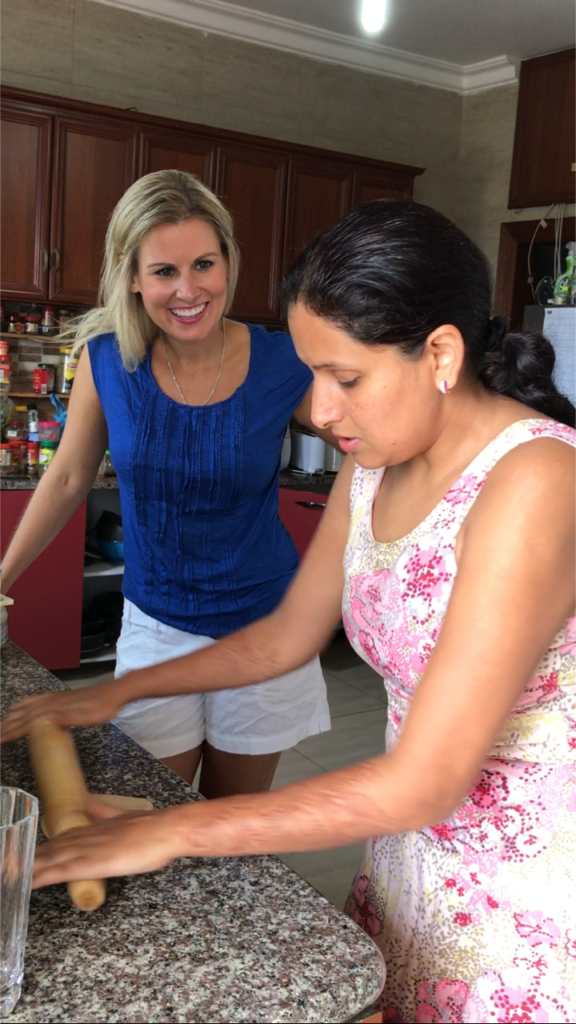 The rounds were rolled out and gently slid into the oil.
The rounds were rolled out and gently slid into the oil. 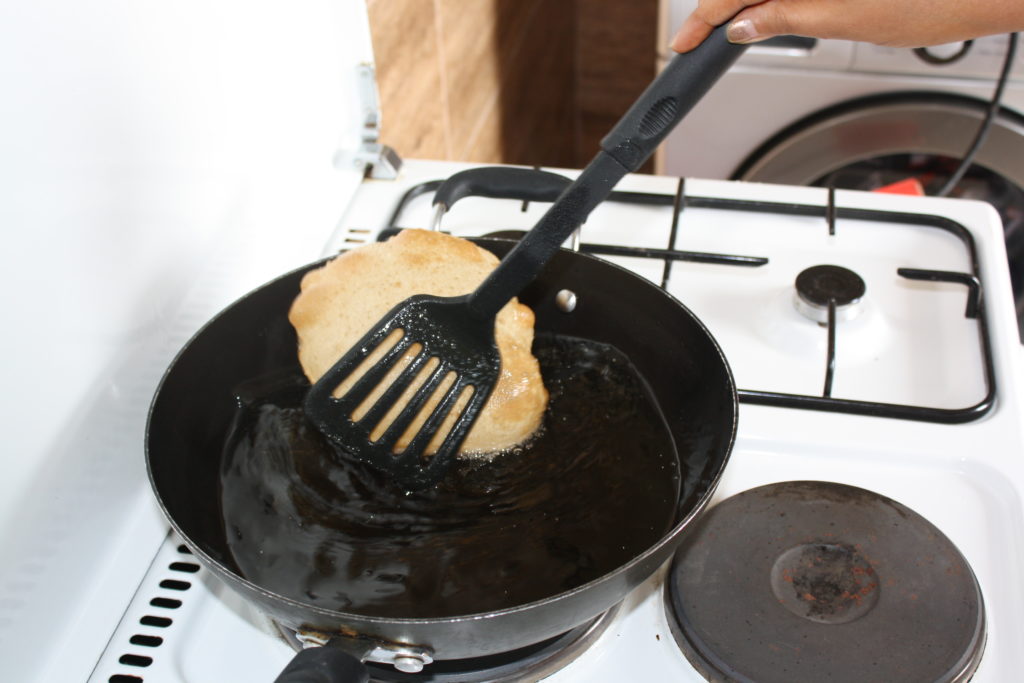 They almost instantly puffed up into fluffy balls of doughy goodness.
They almost instantly puffed up into fluffy balls of doughy goodness.
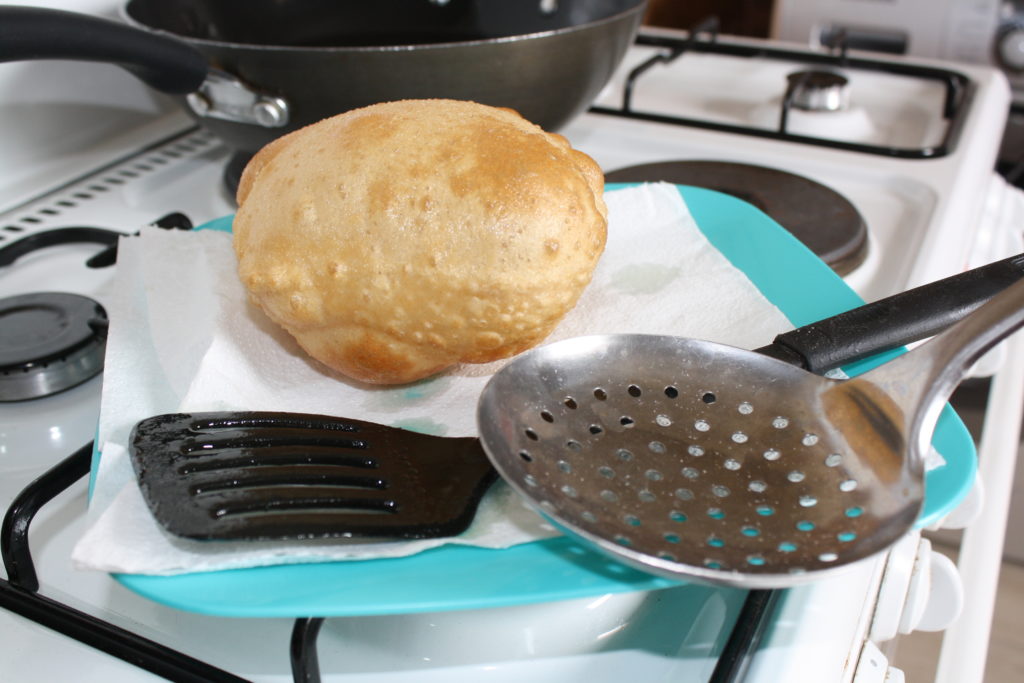 The difference in the two dough types was the kind of flour she used and I was about to taste test both, along with the other things we made.
The difference in the two dough types was the kind of flour she used and I was about to taste test both, along with the other things we made.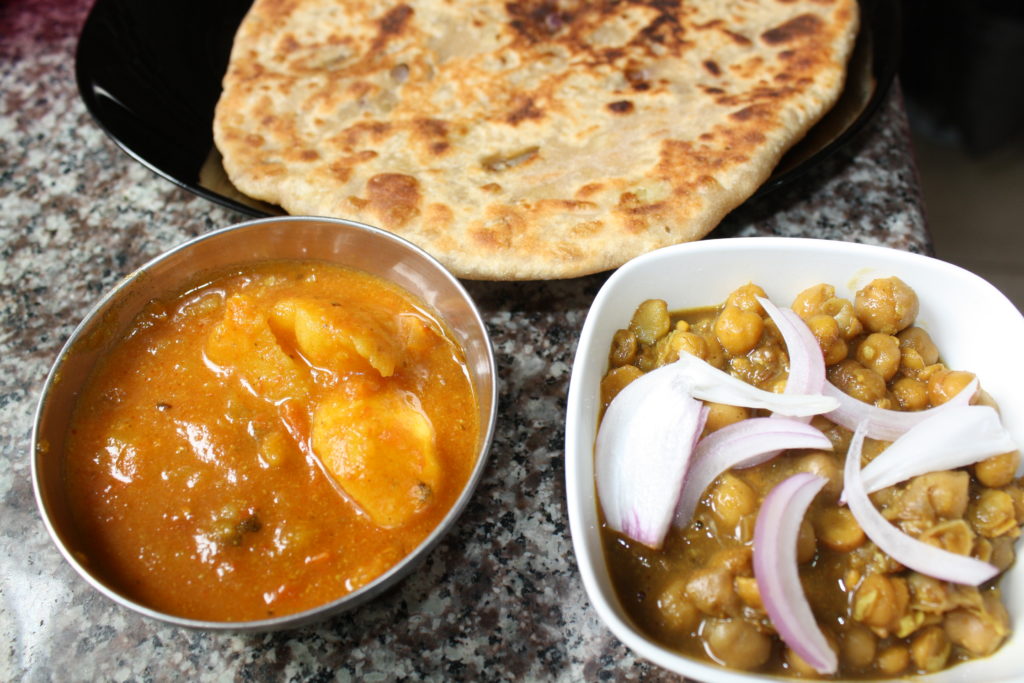 Now was the moment I’d been waiting for since I smelled those chickpeas when I first arrived. It was time to dig in!
Now was the moment I’d been waiting for since I smelled those chickpeas when I first arrived. It was time to dig in!
I felt like I was born for this moment, yet, culturally, I wasn’t sure how to attack what was in front of me. I knew from my travels that cutlery often doesn’t enter the scene in India, so I looked to my friend to guide me on etiquette.
“Come, let me show you,” she led me over to the bread.
I was instructed to simply rip off a piece of bread and curve it like a spoon, then dig in.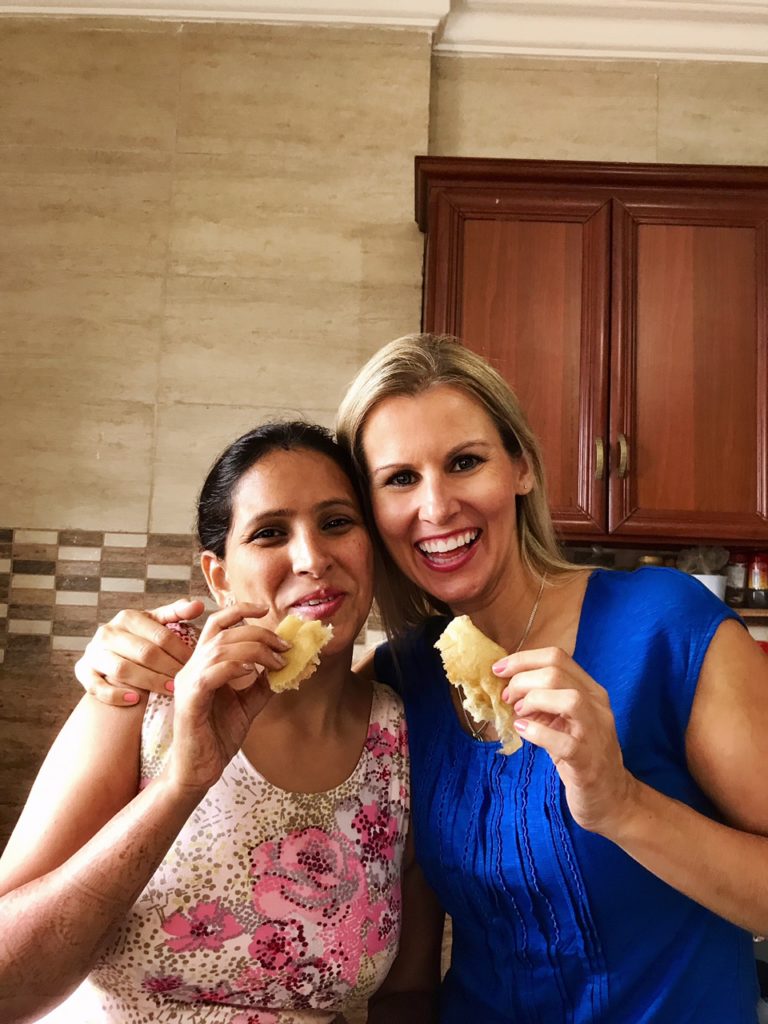 So I did.
So I did.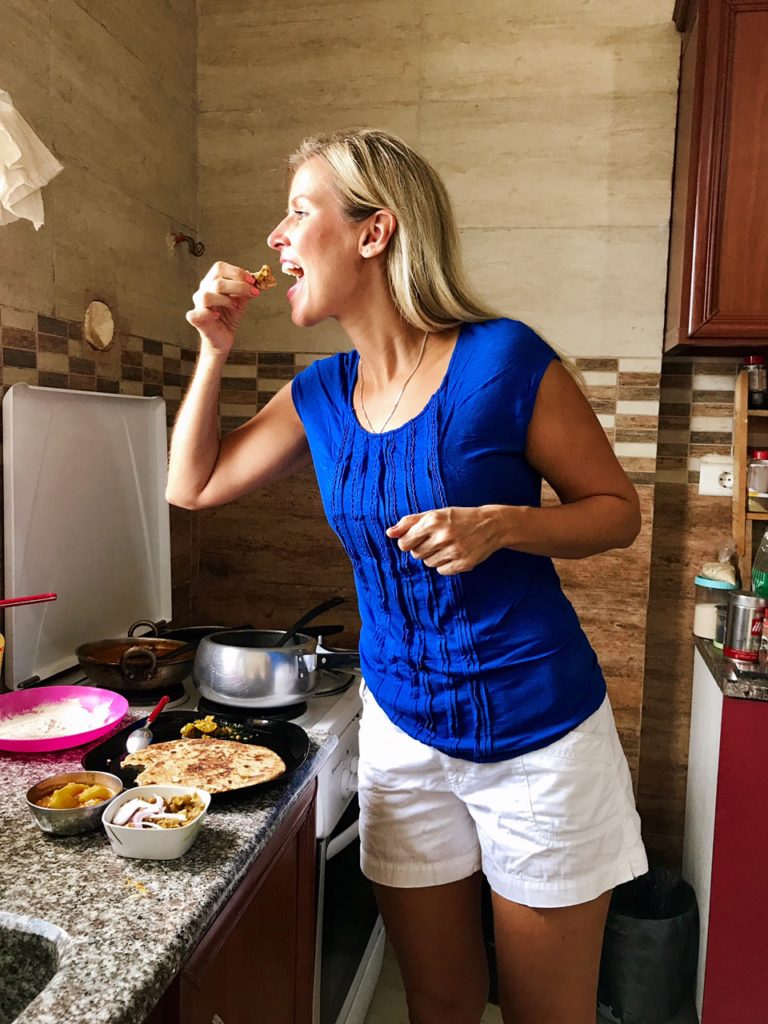 The results?
The results? AMAZING
AMAZING
And just when I though, Wow that was a lot of cooking. Pallavi tells me she’s going to make tea. But of course it’s not just slipping a tea bag into some water with this gal. She heads over to her shelves and grabs a bunch of spices to throw into a pot for chai. 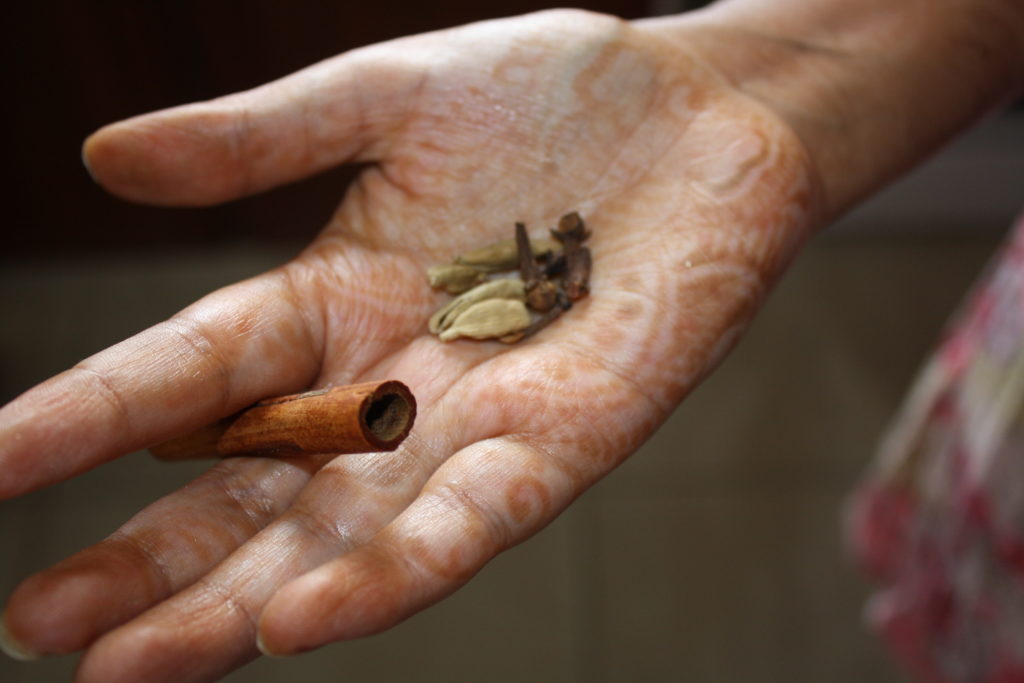 Crushed ginger, cardamom, cloves and cinnamon, to be precise. She put them in water to boil, added 1 and a half teaspoons of loose tea and milk and brought it to a boil. Then added sugar and simmered.
Crushed ginger, cardamom, cloves and cinnamon, to be precise. She put them in water to boil, added 1 and a half teaspoons of loose tea and milk and brought it to a boil. Then added sugar and simmered.  As Pallavi carefully poured the tea I had a little moment of reflection at the pride we each carry in our home country’s culture even we are no longer living in it. Perhaps more so when we are no longer living in it. It’s as though we become the face of our country and I’m not sure whose face was happier, Pallavi’s, because of how much I enjoyed what she made, or me, because I got to be on the receiving end of this culinary delight!
As Pallavi carefully poured the tea I had a little moment of reflection at the pride we each carry in our home country’s culture even we are no longer living in it. Perhaps more so when we are no longer living in it. It’s as though we become the face of our country and I’m not sure whose face was happier, Pallavi’s, because of how much I enjoyed what she made, or me, because I got to be on the receiving end of this culinary delight!
Indian cooking is a labour of love. It is not as easy as a ready-made meal you grab from the store. But a ready-made meal wouldn’t have us eating it right out of the pan!
This stuff really was to die for.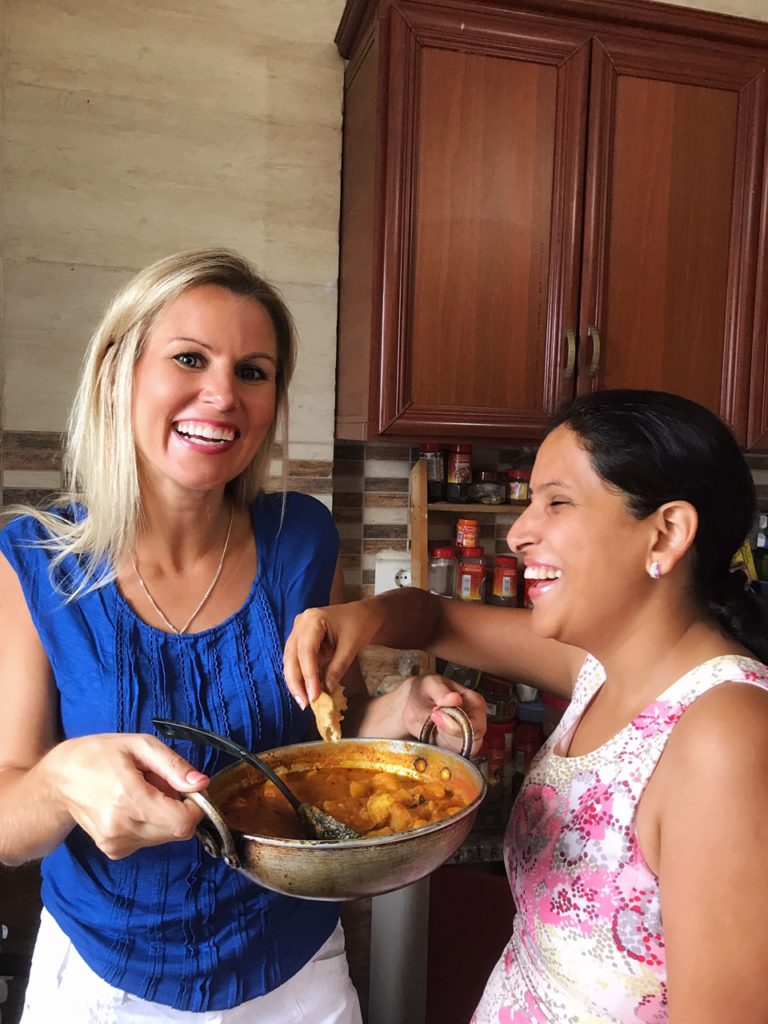 Thanks to my friend Pallavi, for taking the time to share a little piece of her home country with me.
Thanks to my friend Pallavi, for taking the time to share a little piece of her home country with me.
The Recipes:
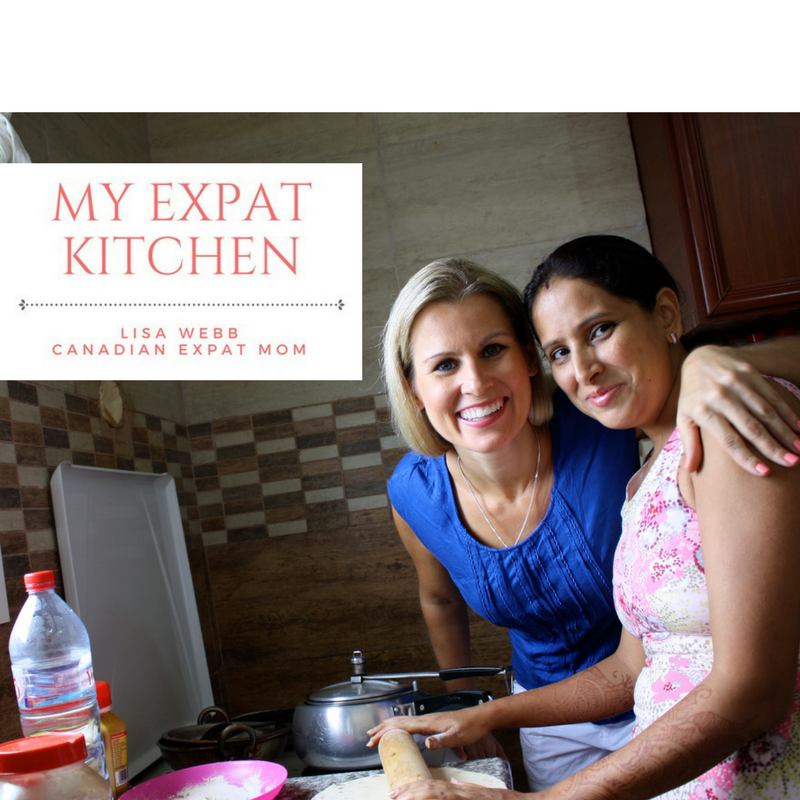 Chhole (pindi chana- chickpeas cooked village style):
Chhole (pindi chana- chickpeas cooked village style):
Dough for Poori:


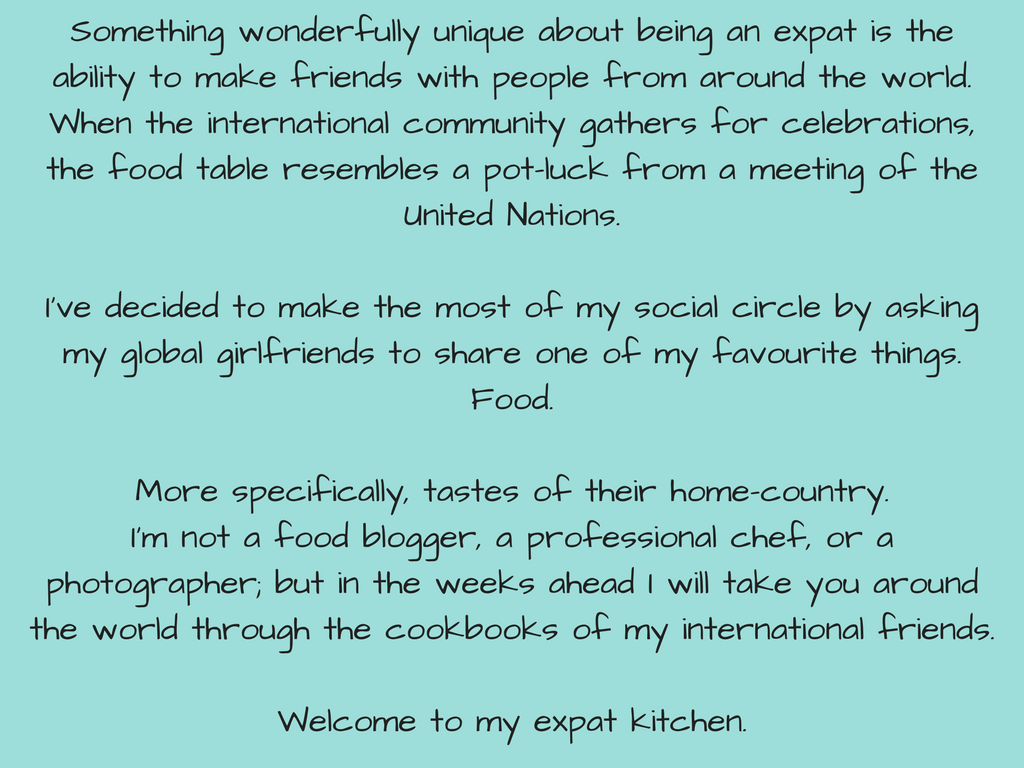
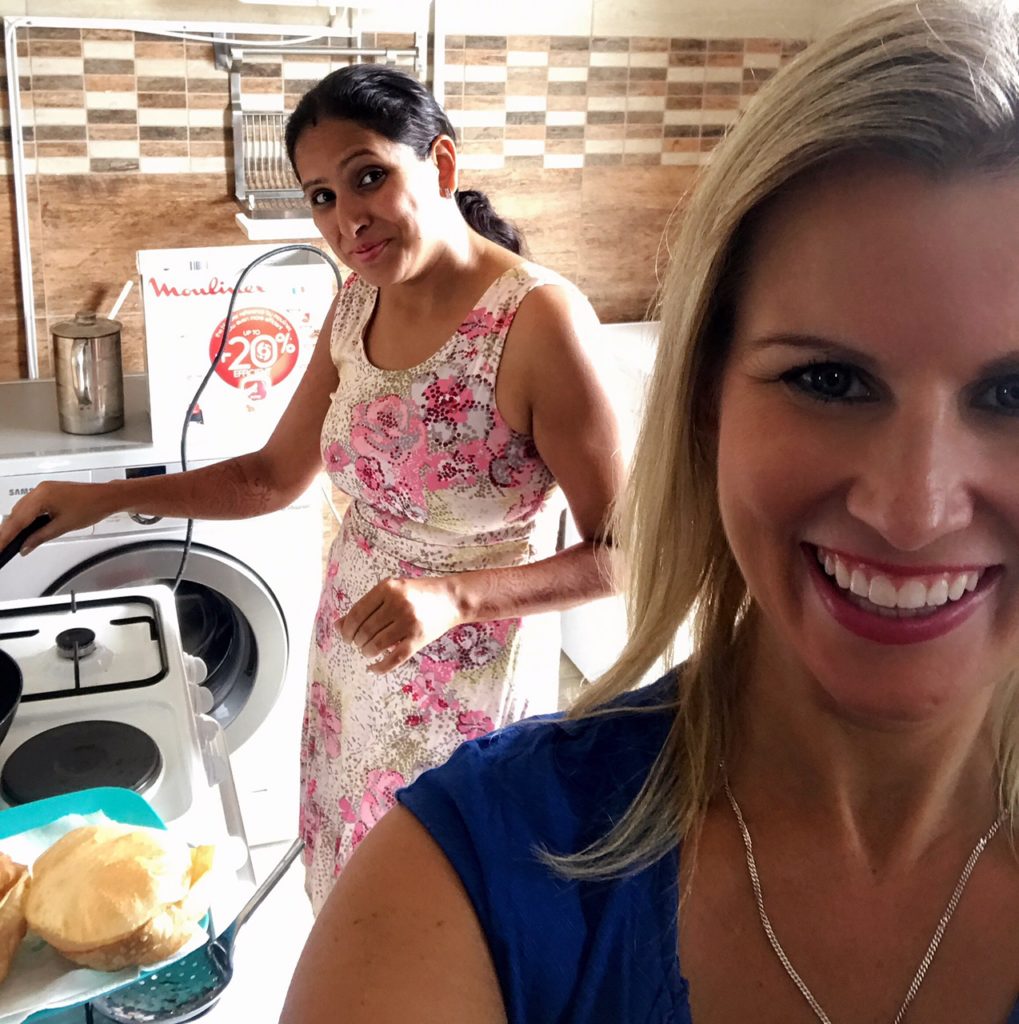
I LOVE the video! Can’t wait to see more cooking adventures!!! ❤️
Video looks great! Well done xx
Thanks! It was learn-as-you-go. 😉